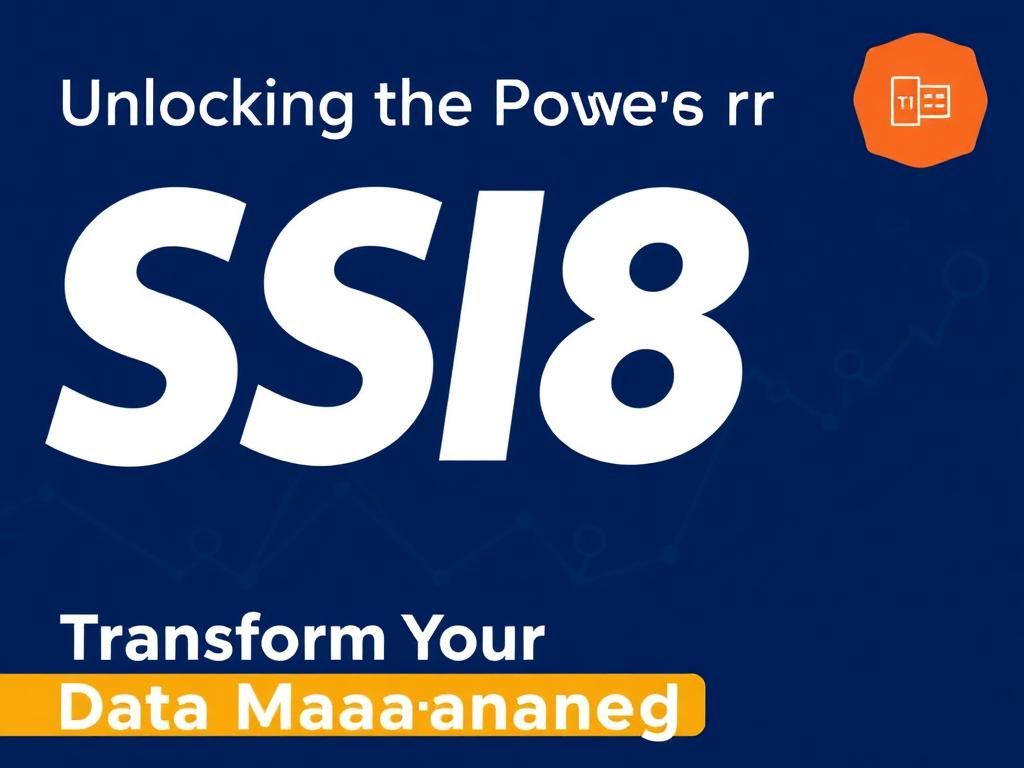Physical Address
304 North Cardinal St.
Dorchester Center, MA 02124
Physical Address
304 North Cardinal St.
Dorchester Center, MA 02124
In the modern data landscape, organizations are constantly seeking efficient methods for data integration and transformation. SQL Server Integration Services (SSIS) has emerged as a robust tool for managing these processes. Among the various iterations and enhancements of SSIS, SSIS-858 stands out as a vital resource for practitioners looking to optimize their data workflows. Understanding SSIS-858 can enhance data integration projects significantly, making it critical for businesses engaged in data management to explore its capabilities and applications.
SQL Server Integration Services (SSIS) is a platform for data integration and workflow applications. It allows users to perform data extraction, transformation, and loading (ETL) from a wide range of sources. SSIS is primarily used for data warehousing, data migration, and business intelligence (BI) solutions. Companies leverage SSIS to manage large data sets, ensuring that data is accurate, reliable, and available for analysis.
SSIS-858 specifically refers to a version or enhancement of the SSIS platform that incorporates advanced features aimed at improving data management tasks. Identifying and leveraging SSIS-858 within the context of SSIS allows organizations to utilize its full potential, streamlining data processes and elevating operational efficiencies.
One of the significant advantages of SSIS-858 is its comprehensive capability for ETL. This functionality includes:
Additionally, SSIS-858 supports a wide array of data sources and formats, making it adaptable to many integration scenarios.
Performance is a critical aspect of SSIS-858. This version introduces various techniques aimed at boosting data processing efficiency, such as:
By optimizing these processes, organizations can significantly reduce loading times and improve resource utilization.
SSIS-858 showcases robust integration capabilities with other systems, which is essential in today’s multi-platform environments. Key features include:
SSIS-858 proves invaluable in data migration projects. Typical scenarios include:
The steps involved in a data migration project using SSIS-858 typically encompass planning, execution, and validation of data integrity following the transfer.
For businesses investing in data warehousing, SSIS-858 serves a critical role in ETL processes:
Companies that apply SSIS-858 within their data warehousing strategies have successfully improved access to meaningful insights.
In preparing data for BI tools, SSIS-858 is utilized effectively:
For example, organizations have seen enhanced reporting capabilities by implementing SSIS-858 in their data processing workflows.
The architecture of SSIS-858 is designed to facilitate efficient data flow and control. Important components include:

Deploying an SSIS-858 project requires several essential steps:
Implementing SSIS-858 may come with hurdles, such as:
To address these challenges, employing best practices, such as regularly monitoring performance and incorporating robust testing phases into the deployment process, can greatly enhance results.
With a focus on data quality, SSIS-858 helps maintain high standards during integration. Implementing validation checks within the ETL process ensures that only high-quality data enters the system.
Through the deployment of SSIS-858, organizations have reported greater efficiencies in their business processes. With faster data integration and improved data quality, decision-makers can rely on accurate data for strategic initiatives.
One of the standout features of SSIS-858 is its capability for real-time data processing. This ability equips organizations to make decisions based on the most current data available, enhancing responsiveness to market conditions.
As data technologies evolve, so does SSIS. Organizations can anticipate several improvements related to SSIS-858, including:
In the broader ecosystem of ETL tools, SSIS-858 remains competitive. Its robust feature set and seamless integration capabilities set it apart from other platforms, maintaining its relevance amidst emerging technologies.
This article explored the critical aspects of SSIS-858, covering its functionalities, integration capabilities, and impact on data management. The value of SSIS-858 in addressing modern data challenges cannot be overstated.
For organizations aiming to enhance their data integration strategies, embracing SSIS-858 can lead to significant efficiencies and improvements. Adopting this technology is a step toward more effective data management.

For further exploration, consider visiting the official Microsoft documentation for SSIS. You can also find numerous online courses offering guided training on SSIS-858.
Many forums exist for discussions related to SSIS-858. Community support channels such as Microsoft’s Tech Community provide a platform for sharing experiences and solving issues.
| Feature | Description | Benefits |
|---|---|---|
| ETL Functionality | Extracts, transforms, and loads data from diverse sources | Streamlined data processing |
| Performance Enhancements | Optimizes data processing for efficiency | Reduced load times |
| Integration Capabilities | Compatible with various database systems | Enhanced flexibility |
| Real-time Data Processing | Enables live data integration | Immediate data availability |
SSIS-858 is an advanced version of SQL Server Integration Services, designed for improved data integration and transformation processes.
It includes enhanced features for performance optimization, integration capabilities, and real-time processing functionalities.
Common use cases include data migration, data warehousing, and business intelligence applications.
Implementation involves setting up the software, designing packages, and deploying them in a suitable environment.
Challenges may include performance issues and data quality concerns, which can be addressed through monitoring and best practices.
Resources are available through official Microsoft documentation, online courses, and community forums.
Yes, it includes features that facilitate integration with cloud-based platforms.
It implements validation checks within the ETL process to maintain high data quality standards.
Yes, it is designed to manage significant volumes of data efficiently through optimized processing techniques.
Its continual evolution and enhancements will maintain its relevance within the broader ETL tool ecosystem.